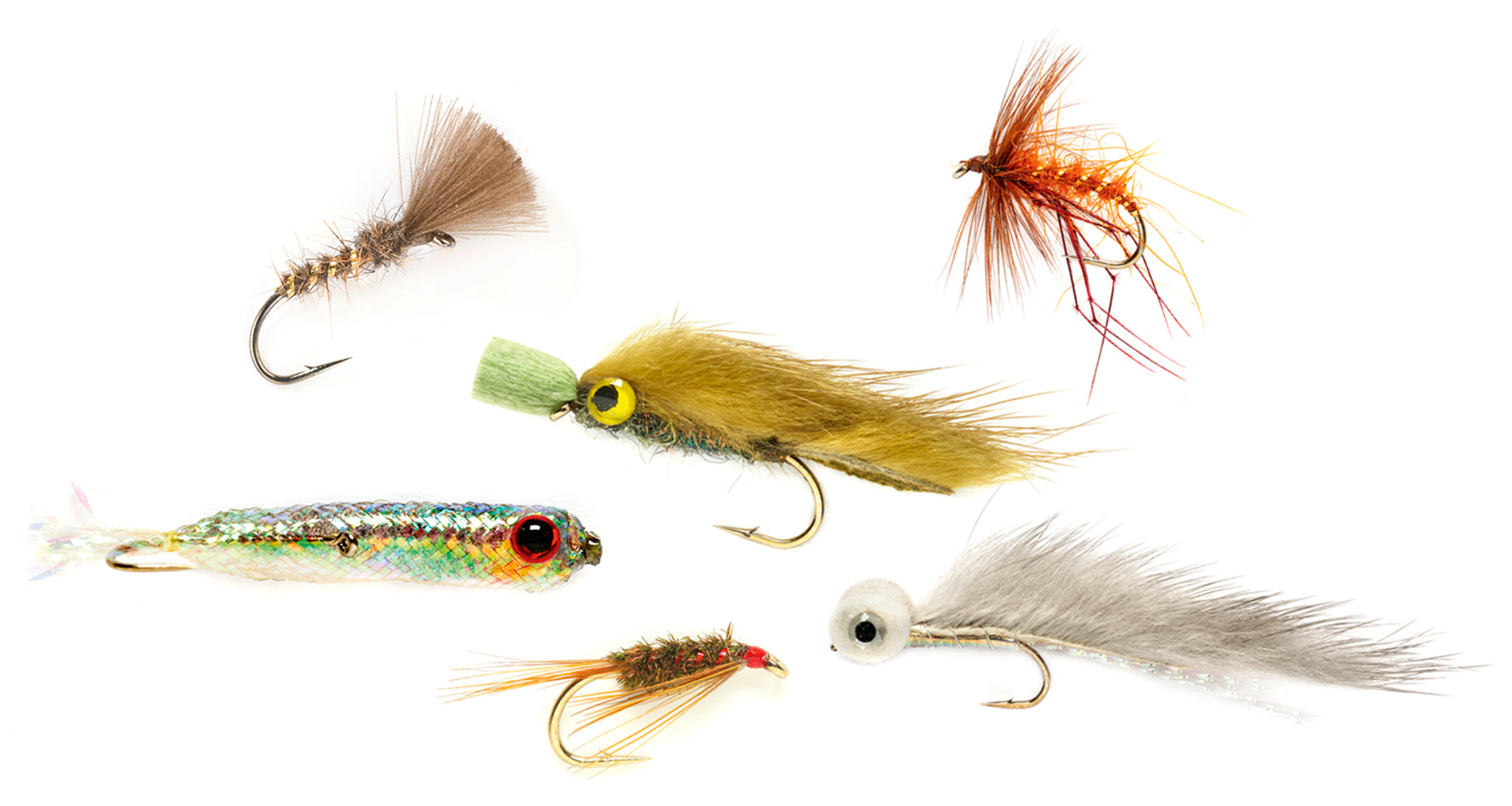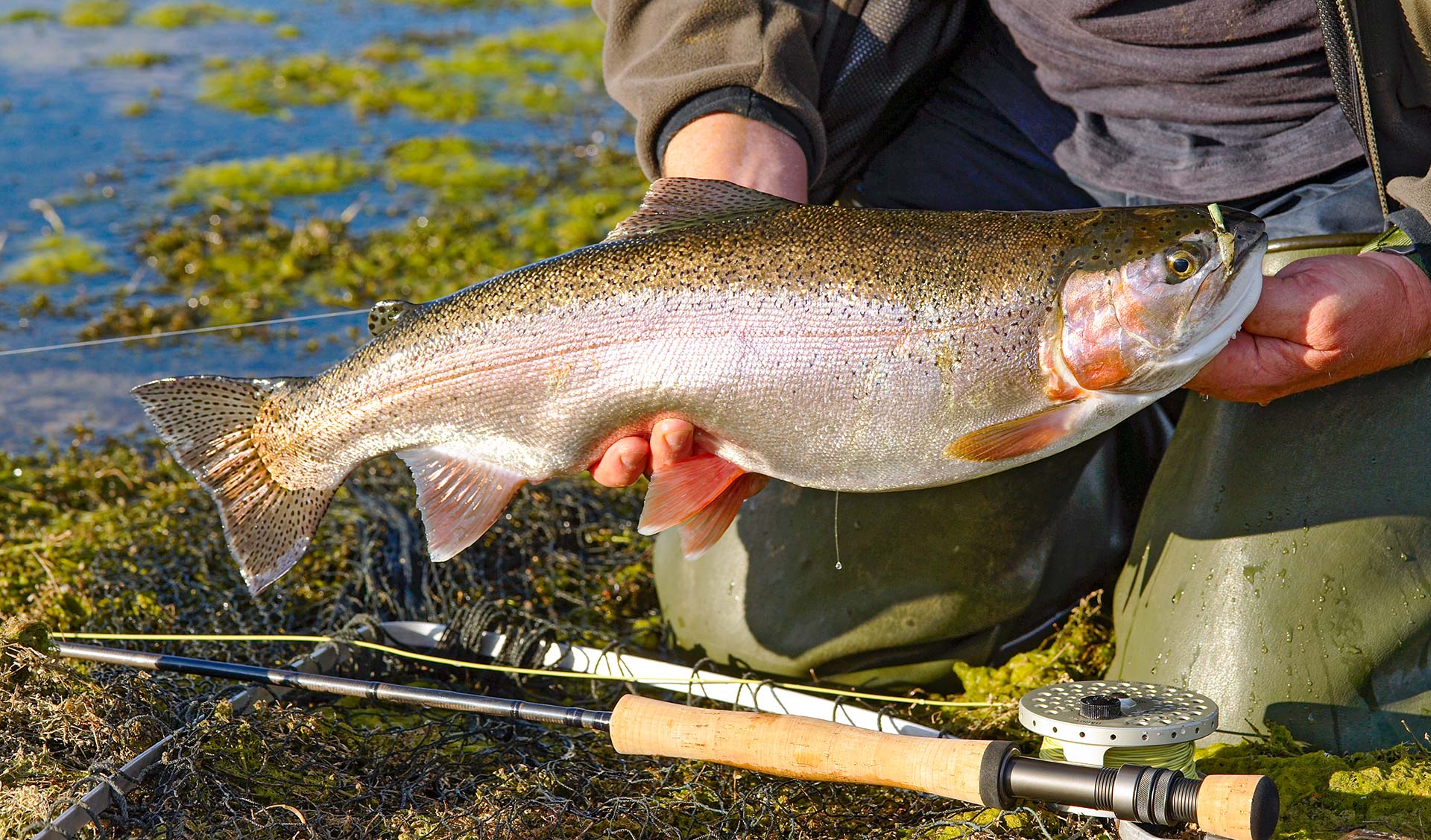Proven techniques for better fishing this autumn
Warm weather and low water levels can lead to rapid weed growth in the shallow areas of reservoirs. Water that is 8ft-12ft deep in the early season can shrink to 3ft-4ft deep. Many anglers avoid these areas, based on the premise that if they can’t see fish, then there are none there. But you should never discount shallow weedy areas as they can provide exciting sport.
Established weedbeds are a haven for corixa, shrimps and fry. They also offer shade and cover
for fish, especially grown-on resident trout, which do not “switch off” like newly stocked fish. They are more accustomed to high and fluctuating water temperatures in the reservoir and will feed naturally around the weedbeds. While they are challenging, these larger fish are worthy of extra effort.
Areas of weed are not affected by high winds and don’t colour up quickly. This clear water is a challenge for the angler to overcome. Numerous casts with weighted flies will result in spooked fish — and it’s impossible to catch a frightened trout. Patience and a stealthy approach are the keys to success.
Channels and holes
At first glance you may think weedbeds are a thick carpet of impenetrable vegetation, but often they have unique features, such as deep holes and channels. These channels are the weed equivalent of wind lanes and should never be overlooked.
One larger main channel is often intersected by smaller side channels. Trout use these channels to search for food. They usually enter the weedbed system via the main channel. This should be where you start as it will allow you to present your flies to the greatest number of fish, which will all pass this point twice — on entry and exit.
First, follow the path of the channels with your eyes to avoid fishing any with dead ends. If you hook a fish it will charge through the weed in an attempt to escape and this usually means breakages. Instead, try to fish channels where there is a clear exit path into clear water.
I’ve noticed that trout often patrol the weedbeds in pairs and will even follow a set route, passing the same position perhaps every five minutes or so. In the shallows of Rutland’s North Arm, I’ve witnessed large browns of 7lb-8lb using the same path through the weed over and over again. This means you can set the perfect trap — you know the route the fish will take, so you can stack the odds in your favour. Rather than casting at the fish when you see it (and potentially spooking it), make a cast a minute or so before you expect the fish to make its next pass. Try to lay your fly-line on the weed with just your leader and fly directly in the trout’s path. There will be no silhouette from your fly-line, no splash from the fly or fly-line hitting the water — your presentation will be perfect. When the fish is just a foot away from your fly make a single short sharp 4in-6in pull. Your fly will move and the fish will react, usually taking the fly. Watch the fish turn on your fly and then lift. In many instances you won’t feel a take at all.
| Set up an ambush |
|
When fishing from a boat, gently motor to the edge of the weedbed and cut the engine 20ft away — but keep the engine in gear so the propeller can be lifted up as you reach the weedbed. Allow the momentum and movement of the boat to push you deep into the bed. You are now effectively shipwrecked on weed. Often there is no need to even use the anchor as the weed will hold you in position. You can fine-tune your position and manoeuvre the boat with the oars. In effect, you have created the perfect ambush opportunity and can fish over the blanket of weed into the drop-off or channel, with both you and the boat hidden from the fish’s view.
This approach is advantageous because you don’t have to repeatedly start and stop the engine, disturbing the shallow water by drifting through it, or dropping and raising an anchor or drogue.
However, the chances are that after catching just a single fish the ensuing fight will have disturbed the water significantly. You will either have to be extremely patient and wait for 30 to 45 minutes for the water to settle or find another area to fish. I usually opt to move.

|
Six flies to try
Clockwise from top right: Ginger Hopper; Minkie Booby; Red-headed Diawl Bach;
Mylar Fry; CDC Hare’s Ear; Suspender Minkie.

Shallow-water tactics
The depth you fish your flies is crucial. You should be fishing in the top 2ft-3ft of water — often less. Any droppers on the cast can easily get caught in weed when a hooked fish runs, causing breakages. I mostly only fish two flies over weedbeds.
There are three simple methods to consider:
Method one: washing line
 My initial set-up is a washing line with a 13ft leader of 8lb degreased copolymer. I use a Mylar Floating Fry on the point and a size 12 or 14 Red Holographic Diawl Bach on the dropper just 3½ft from the point fly — remember that fish have a very small angle of vision in such shallow water. Make a cast, one pull to straighten the line and get you in direct contact, then just fish ultra-slow or static. Fish are often pulled in by the silhouette of the fry pattern and then take the Diawl Bach just beneath the surface.
My initial set-up is a washing line with a 13ft leader of 8lb degreased copolymer. I use a Mylar Floating Fry on the point and a size 12 or 14 Red Holographic Diawl Bach on the dropper just 3½ft from the point fly — remember that fish have a very small angle of vision in such shallow water. Make a cast, one pull to straighten the line and get you in direct contact, then just fish ultra-slow or static. Fish are often pulled in by the silhouette of the fry pattern and then take the Diawl Bach just beneath the surface.
In flat calms, I prefer a Suspender Minkie on the point. The mink tail imparts movement and often that’s enough to induce a take and turn swirls into positive takes. A Suspender Minkie can also be given a sharp strip to create a “pop”, creating disturbance that pulls the fish to your cast.
Method two: single Booby
 If fish react to the disturbance caused by the Suspender Minkie, try fishing a single Minkie Booby on a floating line. Use a 13ft leader of 8lb fluorocarbon and a size 8 Minkie Booby with 6mm or 7mm eyes. The fly is about 2in long and a perfect fry imitation. It has the added advantage of being tied on a heavy wire hook and shouldn’t bend under the sustained pressure of a long hard fight.
If fish react to the disturbance caused by the Suspender Minkie, try fishing a single Minkie Booby on a floating line. Use a 13ft leader of 8lb fluorocarbon and a size 8 Minkie Booby with 6mm or 7mm eyes. The fly is about 2in long and a perfect fry imitation. It has the added advantage of being tied on a heavy wire hook and shouldn’t bend under the sustained pressure of a long hard fight.
This set-up can be fished over water just a foot deep. Begin by “popping” the Booby with four or five sharp 6in to 12in pulls, which will draw in any fish. Then try a medium-paced figure-of-eight retrieve to wake the fly across the surface. Trout come from nowhere, often bow-waving before the take almost pulls the rod out of your hand.
Method three: dry-fly
 If conditions are favourable, try dry-flies, especially for trout feeding on corixa, snail and shrimp. I keep things simple with a 14ft leader of 8lb degreased copolymer and a CDC Hare’s Ear on point, and a size 12 or 14 orange or red Hopper on the dropper (6ft from the point). “Park” your flies over a channel or hole in the weed and wait for the fish to find them.
If conditions are favourable, try dry-flies, especially for trout feeding on corixa, snail and shrimp. I keep things simple with a 14ft leader of 8lb degreased copolymer and a CDC Hare’s Ear on point, and a size 12 or 14 orange or red Hopper on the dropper (6ft from the point). “Park” your flies over a channel or hole in the weed and wait for the fish to find them.
When using dry-flies expect to lose a few fish. A 3lb trout can easily snap an 8lb leader, so you cannot bully them on light wire hooks. It’s often a case of pile on the pressure and apply side strain. Try to turn the fish into open water.
Trout can easily make 30-yard runs, so set your drag correctly. You do not want the reel to overrun and tangle, or the drag to be so stiff that the hook simply pulls out or the leader snaps. It’s a fine balance and you won’t get many second chances. Any fish hooked in shallow water will instinctively bolt for safety — this means deep water some distance away or a weedbed. Keep your rod high and as much fly-line off the water as possible. If it lies on the water, it causes drag and resistance and can easily pull small hooks out or straighten them.
Ensure your fly-line and backing won´t tangle around weed or your feet. A fit 3lb rainbow can take a full line in just a few seconds and you will have little time to react.
Accept that you will lose at least one in every three fish hooked, but that makes the ones landed all the more special.
 You’ve a chance of catching bigger fish near weedbeds.
You’ve a chance of catching bigger fish near weedbeds.
Discover the latest tactics from the UK's leading fly-fishers every month in Trout & Salmon magazine. Subscribe or buy single issues here